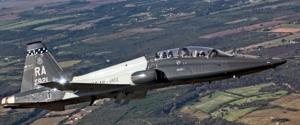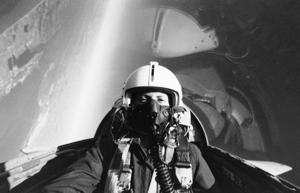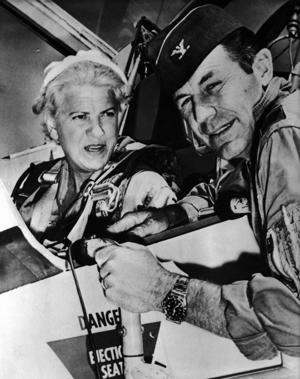In April 2008, a T-38 trainer took off from Columbus Air Force Base in Mississippi. Within seconds, it rolled onto its back and crashed, killing the instructor and student.
A metal lever had broken on an aileron, a wing control surface, causing the plane to flip.
The T-38 was a very old plane then, and it’s older now. Northrop Grumman built the first in 1959 and ended production in 1972. But it’s still one of the main means of training military pilots.
Now, the Air Force would like to replace these flying antiques, rather than launch another round of structural fixes designed to prevent accidents.
That desire just might possibly hold promise for jobs at Boeing in St. Louis.
OVER LACKLAND AIR FORCE BASE, Texas -- A T-38 Talon participates in the 2004 Lackland Airfest. (U.S. Air Force photo by Master Sgt. Lance Cheung)
Boeing is teaming with Saab, the Swedish maker of the Gripen fighter jet, to bid for the contract to build the T-38’s successor, nicknamed the T-X. The Boeing project team is based here, and they plan a start-from-scratch entry.
If it can get the funding from Congress, the Air Force may order 350 of the jets over many years, with more sales overseas. Reuters reported the Air Force wants to hold a competition in 2017 for the new trainer program, which is estimated to be worth $11 billion.
It is conceivable that the trainer might, just possibly, keep Boeing workers busy here after the F/A-18, E/A-18 and F-15 fighter programs run out of orders, probably later this decade.
Those are Boeing’s biggest projects in St. Louis, although area workers also work on smart bomb kits, Harpoon missiles and the Small Diameter Bomb. Boeing’s military research and development is done here, as well as some support work on the C-17 transport.
Boeing faces tough competition for the trainer:
• General Dynamics and Alenia Aermacchi, an Italian company, plan to submit a version of the Italian M-346 trainer.
• Northrop Grumman and BAE Systems are preparing to offer a new design. They dropped plans to offer a version of the BAE Hawk.
• Lockheed Martin is teamed with KAI of South Korea, maker of the T-50 trainer used by the South Korean air force.
• Textron Airland may submit a version of the Scorpion, a jet designed for attack and intelligence gathering.
Boeing previously teamed up with Saab to make a rocket artillery version of Boeing’s “small-diameter bomb” capable of traveling around mountains to hit an enemy from behind. It was tested recently.
If Boeing and SAAB get the contract, would they build the trainer in St. Louis?
In this photo provided by NASA, Sharon Christa McAuliffe rides in a T-38 trainer jet over Galveston Bay during training for the launch of Space Shuttle Challenger mission 51-L. Part of Galveston Island and the Houston, Texas metropolitan area can be seen in background at top left, Jan. 16, 1986. McAuliffe, of Concord, N.H. will represent the Teacher in Space Project aboard the Challenger. (AP Photo/NASA) No Sales
“We are currently looking at all options but have not made a decision as to where the trainer will be built,” said Boeing spokeswoman Deborah VanNierop in an email. The trainer’s management team is in the St. Louis area, she added.
But an Air Force contract makes it likely that the main assembly will be in the U.S., and north St. Louis County is where Boeing makes its combat jets. Boeing assembled the Navy’s T-45 Goshawk trainer here in a program that ended in 2009 after 221 deliveries.
Boeing has a very good chance at landing the contract — if Congress provides the money, said Loren Thompson, a national security expert at the Lexington Institute in Alexandria, Va. But money is a big problem.
It’s unlikely that Congress will let the Pentagon loose from the “sequester,” Thompson said. Those are the automatic funding limits imposed after Democrats and Republicans failed to agree on spending in 2011.
The Air Force hasn’t yet put out specifications or asked for bids.
A new trainer is fairly low on the Air Force’s priority list, Thompson said. The generals are more interested in obtaining new F-35 joint strike fighters, new Boeing-built refueling tankers and a new long-range bomber.
Others aren’t so pessimistic about the new trainer.
A replacement for the T-38 “has to happen,” said Richard Aboulafia, vice president for analysis at the Teal Group, an aerospace consulting firm in Washington’s Virginia suburbs. “If you don’t start replacing them in the early 2020s, you have to spend an awful lot of money on structural work.”
And that means development on the new trainer must start fairly soon.
Thompson and Aboulafia disagree about Boeing’s chances of winning the contract if offered.
“Boeing probably has a wider range of experience than any of the other competitors,” said Thompson, who thinks Boeing has the lead. “It not only has a technological edge, but its the leader in the world in getting the costs down.”
America's Veteran Woman Pilot Jacqueline Cochran sits in the cockpit of a T38 Jet Trainer with Colonel Chuck Yeager in the Edwards Air Force Base, California on Aug 25, 1961. The day before she made a record breaking flight at 842.6 miles an hour which is a new speed mark for women aviators. Colonel Chuck Yeager is the first man to fly faster than sound and who taught her to fly the T38. The present women's air speed record is 715.97 mph, held by Jacqueline Auriol of France, unseen. (AP Photo/Str/NAP)
Aboulafia finds Boeing more evenly matched. “I can’t give them more than a one in four chance,” he said.
The Air Force is looking for a trainer better adapted to preparing pilots for the F-22 and F-35, the newest attack fighters in America’s lineup. The requirements are likely to include high speed and the ability to sustain high g-forces.
The old T-38 is a supersonic aircraft capable of climbing to 30,000 feet in one minute.
“The challenge with T-X is, can we truly get a good trainer for a good price without doing development? That’s kind of our goal, not develop something new,” said William LaPlante, the Air Force’s undersecretary for acquisition in September, as quoted in the weekly military publication Air Force Times.
LaPlante said the requirements for the contract would be “reasonable enough that we can make sure there is a good, healthy competition for a non-development solution.”
The Air Force may also want a plane that can play the role of enemy aggressor in pilot training, Defense News reported last month, quoting budget documents.
The T-38 can’t imitate modern enemies well, and the Air Force may want an alternative cheaper than using F-35s in mock dogfights with student pilots. The winner of the trainer contract could produce a “red air” aggressor version.
According to Defense News, two top generals last month said there was no decision to design the T-X as an aggressor. Gen. Robin Rand, head of Air Education and Training Command, said he was intent on keeping the program on track just as a trainer.
The long-range bomber project provides a better bet for evmployment here, Thompson said. “The thing that’s going to stabilize employment in St. Louis the new bomber.”
Boeing, teamed with Lockheed Martin, is competing against Northrop Grumman for the bomber deal worth $55 billion over many years.
Winning that bomber contract is “a near certainty for Boeing,” said Thompson, although Aboulafia puts the likelihood at 50/50.
Last year, the state of California offered $420 million in tax breaks if Boeing builds the bomber in California, where the Air Force has its own secrecy-heavy plant. Boeing had requested the subsidy.
Such big projects are often shared around. St. Louis, as Boeing’s defense hub, could expect part of the work even if the North County plant didn’t land the major assembly job.



Комментариев нет:
Отправить комментарий